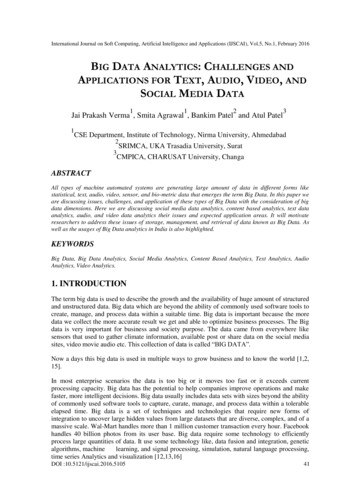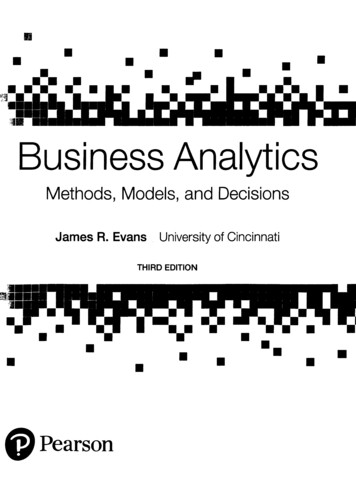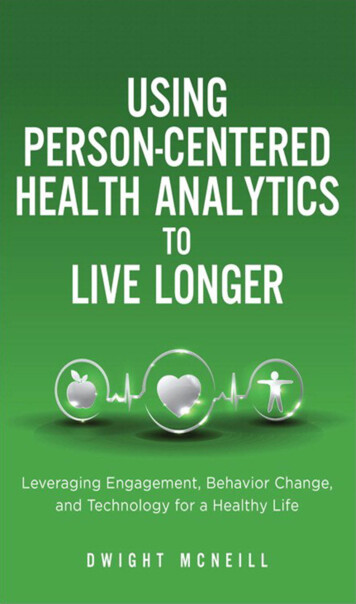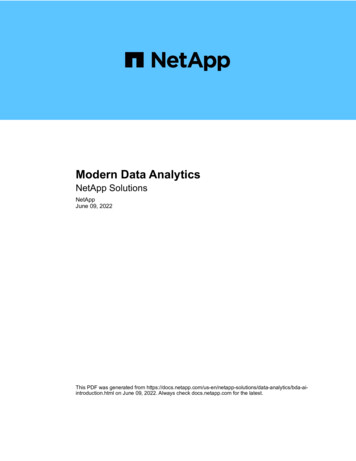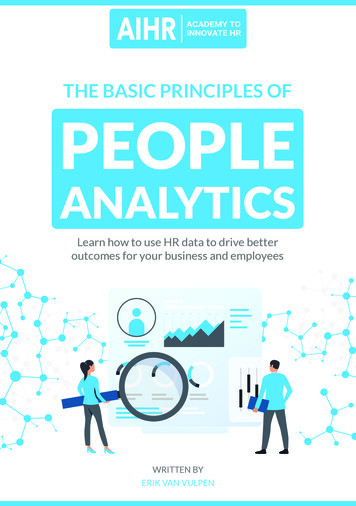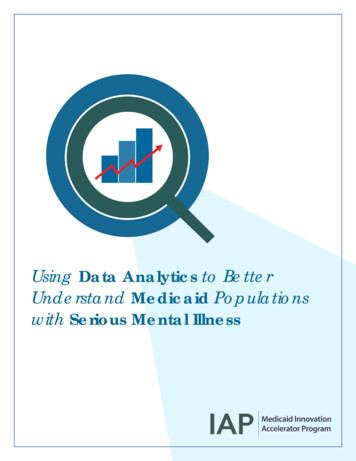
Transcription
Using Data Analytics to BetterUnderstand Medicaid Populationswith Serious Mental Illness
Main ObjectivesThis technical resource outlines preliminary steps that state Medicaid agencies can use to identifyMedicaid adult beneficiaries with Serious Mental Illness (SMI) and to gain a better understanding of thispopulation to inform future decision-making. This resource also provides examples of potential dataoutputs that can be replicated using a state’s Medicaid data.Table of ContentsA. Background . 3B.Objectives . 4C.Organization of the Technical Resource . 4D. Preliminary Considerations . 5E.Analysis of Beneficiary Data . 9F.Analysis of Utilization Data . 19G. Analysis of Cost Data . 25H. Further Possibilities for Using Medicaid Data . 29I.Next Steps . 30J.Conclusion . 32K.Acronyms . 332
Using Data Analytics toBetter UnderstandMedicaid Populationswith Serious Mental IllnessA. BackgroundMany state Medicaid agencies are planning, designing, orimplementing delivery system reforms to improve health outcomesand reduce the total cost of care for individuals with Serious MentalIllness (SMI). This has prompted states to seek a morecomprehensive understanding of service needs, cost trends, anddelivery system processes. The Medicaid Innovation AcceleratorProgram (IAP) created this technical resource to help states withinitial data analytic efforts using Medicaid claims and encountersdata and to gather specific insights about adults receiving Medicaidwho have SMI.National MedicaidCoverage andSpending forMental Illness andSUD Treatment In 2014, Medicaid accountedfor 25 percent of totalnational expenditures formental health, and 21percent of total nationalexpenditures for substanceuse disorder services. Morerecent data shows thatMedicaid covered 21 percentof all adults with mentalillness and 26 percent of alladults with SMI. 1Medicaid data is a useful resource to assist states in better understanding how to address the needs ofthe individuals they serve. Medicaid claims data, including encounters from managed careorganizations (MCOs), in combination with Medicaid eligibility and provider files, are a rich source ofinformation about Medicaid beneficiaries and the services they utilize.This technical resource focuses specifically on the use of Medicaid data to understand demographicand diagnostic characteristics of adults with SMI, as well as their utilization patterns and the cost ofservices they access. In this document, high-level instruction is provided to assist states in conductingpreliminary analyses of populations with SMI and to identify where additional analysis could revealhelpful insights. Key considerations for states pursuing these analyses are also included.State Medicaid agencies can use this resource in collaboration with state behavioral health (mentalhealth and substance abuse) authorities to foster mutual understanding of Medicaid beneficiaries withSMI, key population attributes, their use of Medicaid services, and Medicaid service costs. 1About the Medicaid Innovation Accelerator Program (IAP)In July 2014, the Centers for Medicare & Medicaid Services (CMS) launched a collaboration betweenthe Center for Medicaid and CHIP Services and the Center for Medicare & Medicaid Innovation calledthe Medicaid Innovation Accelerator Program (IAP). The goals of IAP are to improve care for Medicaid1Source: Kaiser Family Foundation Medicaid’s Role in Behavioral Health.3
beneficiaries and reduce costs by supporting states in their ongoing payment and delivery systemreforms through targeted technical support, such as this technical resource.B. ObjectivesThe objective of this document is to outline preliminary steps state Medicaid agencies can take toidentify adult Medicaid beneficiaries with SMI and to gain a better understanding of the population(e.g., size, geographic distribution, demographic and diagnostic characteristics, service utilization, andservice cost) that may be used to inform program management decision-making. Information gleanedfrom states’ analyses can also lay the foundation on which the state Medicaid agency can build furtheranalyses to identify: 1) potential issues related to care access, quality, service gaps, and cost trends; 2)program design options, such as whether additional services should be covered or additional Medicaiddelivery system strategies pursued; 3) cost and utilization patterns to be further validated specific tothe population with SMI; and 4) the effectiveness of initiatives designed to improve care forpopulations with SMI.This resource can be used to enable Medicaid directors, policy developers, data analytics staff andother program personnel to understand the types of analysis and information that can be generatedusing Medicaid data (claims, encounters, beneficiary and provider data), as well as other data readilyavailable to state Medicaid agencies such as local geographic data. This resource does not providespecific programming logic nor defines a specific set of detailed data queries.C. Organization of the Technical ResourceThis resource contains three types of analyses: beneficiary, utilization, and cost. Each of these providesan overview of the analyses, example questions to be answered by these data, minimum data requiredfor each analysis, a high-level approach for carrying out the analyses, and output tables or graphs. Theoutput examples in this technical resource are not based on actual data from any specific state. Toreflect this, the examples are marked as “mock data.” This mock data should not be used asbenchmarks.The following describes the three types of analyses:1. Analysis of Beneficiary Data focuses on understanding the adult population with SMI, andon key considerations for states interested in developing a definition of SMI to answer theanalytical questions being asked. The population with SMI can then be stratified according tocharacteristics such as gender, race, age, and diagnosis.2. Analysis of Utilization Data focuses on using Medicaid data to understand use of services.Table examples include: top services by utilization, utilization of select procedures, and averagelength of stay (ALOS).3. Analysis of Cost Data focuses on analyzing and understanding the cost of care provided toadult Medicaid beneficiaries with SMI. Table examples include: average annual cost of care bySMI condition, and top services reimbursed for the population with SMI by cost.4
D. Preliminary ConsiderationsThis section covers three areas, that states should consider addressing, before beginning thebeneficiary, cost, and utilization analyses. The selected definition of SMI used for purposes of these analyses will be critical in guiding thescope of analysis and output. As such, the first part of this section provides considerations foridentifying which definition to use. As claims data are the most critical building block for the analyses, the second part of thissection provides some explanation for how these data can be valuable to state Medicaidagencies embarking on an analysis of their population with SMI. To best understand the adult population with SMI, it may be helpful for state Medicaid agenciesto establish a comparison group of adult Medicaid beneficiaries without SMI. The third partdescribes how defining a comparison group to analyze alongside the population with SMI canprovide additional insights.Determining the Scope of the AnalysisThis resource is tailored to states seeking to better understand their Medicaid population with SMI.One of the early steps a state will need to take is to determine the scope of its analysis. This starts withdefining the population to be analyzed and developing the related specifications (e.g. diagnosis codes,thresholds) to isolate that population. This resource does not use a specific SMI definition since statesdefine SMI in different ways depending on the entity, context, and purpose for which it is being used(e.g. legal, clinical, epidemiological, or operational). Further, the beneficiary population that the stateidentifies for its analyses may align with or build upon the state’s statutory definition of SMI, federaldefinitions, or other sources. As the state Medicaid agency considers whether to adopt or refine anexisting definition of SMI for purposes of this analysis, it should take into account how the definitionaligns with its policy and programmatic priorities for its Medicaid population.Many definitions of SMI, including the formal definitions adopted by the U.S. Department of Healthand Human Services and the Social Security Administration, are based on a finding that the conditionhas resulted in serious functional impairment which substantially interferes with or limits one or moremajor life activity.2 However, because these definitions rely on information that is not typicallycaptured in claims data, they may not be operationally practical for use in developing specifications toThe SAMHSA National Registry of Evidence-based Programs and Practices (NREPP) provides a discussion ofthe U.S. Department of Health and Human Services’ definition of SMI, including the evolution of the terms andmeaning within a recovery framework. For more information, -Behind-the-Term-Serious-Mental-Illness.html.The Social Security Administration (SSA) also provides guidance on determining eligibility for SupplementalSecurity Income (SSI) benefits for those with mental health conditions. Although a clear distinction betweenmental health “impairment” and SMI is not offered, the information documents the final rule for the structure ofa mental disorder claim evaluation by the SSA. 16-22908.pdf. States can use these resources to inform discussions on specific decisions regarding diagnosticcategories and severity when defining SMI.25
identify the population to be analyzed using this resource (which is structured to rely solely onMedicaid claims data).In addition, states can also define SMI statutorily to establish eligibility criteria for certain publiclyfunded behavioral health treatment services. For example, a state’s statutory definition of SMI could belimited to preserve resources for a population determined to be most in need of comprehensiveservices, but this may not be the most appropriate definition for purposes of analyzing a state’scomplex need or high-cost Medicaid population with serious mental illness.A state might also want to use more than one parameter when defining the scope of the targetpopulation for analysis. For instance, states might consider including diagnosis coupled with serviceutilization to define the target population for analyses. The following are examples of how states mightuse diagnoses and utilization parameters as they select their SMI target population for analysis. Notethat the examples provided can be used to study a broad group of Medicaid beneficiaries with SMI, amore targeted group of beneficiaries with SMI, or a combination of broad and targeted sub-group(s) ofbeneficiaries with SMI. Some options for defining the scope of the population for analysis are asfollows: Using some or all of a set of diagnoses associated with SMI to create the target populationcohort; for example, analyses could:o Target a broad population by including schizophrenia, major depression, and bipolardisorder, as well as other diagnoses such as schizoaffective and other psychoticdisorders (e.g. ICD-10 codes F20.x-F33.x)o Target a subset of beneficiaries such only those with schizophrenia, or bipolar disorderIdentifying a set of diagnoses with data queries of service utilization often associated withbeneficiaries with SMI; for, example analyses could:o Define a set of mental health diagnoses that are associated with disproportionately highrates of hospitalization and/or emergency room use for behavioral health reasons (e.g.three or more inpatient psychiatric admissions within a six-month time-period)o Define a set of mental health diagnoses that are associated with use of a state’srehabilitative services option, 1915(i) services, or Targeted Case ManagementRefining or narrowing the target population by examining preliminary indicators of over-,under- or mis-utilization related to the population with SMI within your state Medicaidprogram; for example, analyses could:o Identify all Medicaid beneficiaries with two or more emergency or acute inpatient visitsfor any mental health condition and no associated pharmacy claimso Identify all Medicaid beneficiaries defined by high emergency department use for anymental health condition, along with no utilization of primary care serviceso Identify all Medicaid beneficiaries with at least one inpatient visit or two outpatientvisits for selected mental health condition(s), e.g. schizophrenia, bipolar disorder, etc.,within a specific period of time (suggested one year)As states refine their target population, they may want to review other recent studies, conductedinternally or externally, related to the state’s population with SMI. Similarly, it may also be helpfulto consider documented provider, beneficiary, advocate or other stakeholder feedback related to thepopulation with SMI in the state.6
DocumentDefinitions: Claimsand Encounters For purposes of this resource,references to Medicaidclaims data encompass datafrom both claims andmanaged care encountersused for payment purposesbut do not include providerlevel clinical (e.g. chart)encounter information.Claims: Structured records ofservices or items provided.These are submitted topayers, for a provider toreceive reimbursement forservices. Claims data vary,but usually identify theprovider, beneficiary, andservice information such asdiagnosis, place of service,cost, quantity, date of service,and more.Managed Care Encounters:Records of services or itemssubmitted by managed careorganizations to states toreport on claims paid by theMCOs for services deliveredby providers. These usuallyinclude data elements whichmirror state claims.Clinical Encounters: Detailedprovider records of theservices performed, or itemsprovided, for a beneficiary inan isolated instance for thepurposes of care delivery.Clinical encounters ofteninclude clinical notes andfollow-up actions.Each state Medicaid agency will want to consider a range of factorsin determining the scope of their analyses and should use an SMIdefinition (and related specifications) that meets their needs. Basedon what is learned, states may also want to allow for some furtherrevisions to the definition they use as they study the results of theiranalyses at the various steps in this technical resource.Data Available from Claims and EncountersMedicaid fee-for-service (FFS) claims and managed care encounters(claims data reported by Medicaid MCOs to state Medicaid agencies)provide a rich source of information about Medicaid beneficiariesand the services they use. Claims and/or encounters data will be usedin all analyses described in this resource.Claims data provide information about beneficiaries’ diagnoses andrelated services. Claims will also provide information on theprovider of the service, and the cost of the service. Additionally,claims contain the place of service, which can help researchersunderstand whether the service was delivered at home, in an office,or another setting, such as a hospital emergency department or abehavioral health clinic. The date/dates of service are also located ona claim and may help researchers to determine spans of care andhow often a beneficiary is seeking care. These data can be extremelyhelpful when tracking beneficiary utilization among types ofservices.Claims data can be enhanced by linking additional provider andbeneficiary eligibility information from the state’s informationsystems. For example, some states have identified in their providersystems whether a provider has met patient-centered medical home(PCMH) certification or recognition. Information like this can beimportant when trying to assess the integration of care for Medicaidbeneficiaries with SMI. Consulting other state data sources alsoallows state Medicaid agencies to see which beneficiaries haveMedicare coverage or another third-party insurance and whatreimbursement contributions are being made to the beneficiaries’total cost of care.Important demographic information about the beneficiary, such asage, gender, eligibility category, and whether they reside in thecommunity or institutional setting, can be found in the state’sbeneficiary eligibility subsystem of the Medicaid ManagementInformation System (MMIS). For example, depending on thesophistication of the state’s data system, it may be possible to tell ifthe beneficiary is in a health home or other advanced system of care.7
While claims data can go a long way in providing an understanding of the population with SMI, theydo have limitations. For example, Medicaid claims data will not show how quickly someone could getan appointment. In addition, Medicaid data alone are not representative of total state expenditures forMedicaid beneficiaries with SMI. For instance, Medicaid claims data may not include non-Medicaidmental health services funded with state-only dollars. Each state will need to address limitations thatare specific to their state Medicaid data when conducting their analyses.In addition, some Medicaid services may be provided by a sister agency (i.e. another department oragency in the state). Since payment methods for some of these services may be different from standardMedicaid services, such as being based on allocated staffing costs using a time-study methodology,claims for these services may not contain the same level of detail as provider claims. However, theseclaims still contain data elements that are useful for analysis, such as procedure codes.Population with SMI versus a Comparison GroupComparing a Medicaid population with SMI against a Medicaid population without SMI can provideuseful insight. States can consider identifying a comparison group, defined as the adult populationwithout SMI, based on the state Medicaid agency’s definition of SMI as discussed earlier.For purposes of the instructions included for this technical resource, the comparison group was definedbased on the absence of any primary or secondary diagnosis of an SMI condition (including thosewithout a filled prescription for an antipsychotic within thirty days of a diagnosis).State Medicaid agencies should consider whether an additional subset or subsets of the populationshould be identified and compared to the comparison group to determine if there are indicators ofundiagnosed or unreported SMI, such as those with high emergency department utilization or highreadmission rates. State Medicaid agencies should also consider whether subsets of the populationshould be excluded from analyses, as non-SMI related factors may impact the results of the analyses.For example: The 65 group: Significant portions of service and cost data for this population are covered byMedicare. If research questions are formulated about care management, this population mayimpact the results because many of these beneficiaries primarily receive their services throughMedicare. Institutional populations: When performing analysis, including the institutional populationmay impact results because this population is prone to long and costly hospital stays.It is important to understand all available state Medicaid beneficiary, provider, and claims informationbefore determining the structure of an analysis to avoid inaccuracies and to produce the mostactionable analyses.8
E. Analysis of Beneficiary DataThis section is designed to help states identify their adult SMI and comparison grouppopulations, as well as to identify and understand other basic demographics aboutboth populations. This section will capture: 1) the number of state Medicaid adultbeneficiaries with SMI and in the comparison group; 2) SMI diagnoses among thepopulations identified; 3) population characteristics such as race, ethnicity, age,gender, geographic locale, delivery system, and other population groupings; and 4) prevalence of cooccurring physical health conditions.E.1 Identifying the Population with SMI and the Comparison GroupThe first step in identifying the population of adult Medicaidbeneficiaries with SMI is to work with state policy and clinicalleadership to determine which diagnoses to include in ananalysis of populations with SMI. This may require:1) Selecting the list of diagnosis codes that align withSMI qualifying conditions2) Determining whether the diagnosis needs to bepresent as the primary or secondary diagnosis, orwhether the diagnosis can appear anywhere on theclaim (typically, primary and secondary diagnoses arethe most reliable for isolating a defined condition,though claims data may allow providers to reporteight or more diagnosis codes)3) Determining whether further confirmation of thediagnosis of an SMI qualifying condition is required(e.g. through the presence of a pharmacy claim for apsychotropic medication) to determine if thebeneficiary is under active treatmentUsing Pharmacy Claimsto Confirm SMI Confirming diagnosis codes withthe presence of a pharmacy claim isa common method for determiningwhether a beneficiary has a givencondition. The definition logic fordetermining SMI used in thisresource includes the presence of apharmacy claim as a criterion.This approach, however, mayunintentionally excludebeneficiaries who should be taking amedication but have not filled theirprescription. Separate analysis onmedication gaps is required toidentify this population.Additional criteria or logic can be applied to the analyses tofurther refine these populations. For instance, since many states experience significant eligibility churnin their Medicaid population, state Medicaid agencies may not want to require continuous enrollmentduring the entire period studied, as it might exclude many high-cost, high-need beneficiaries in thepopulation group. The examples in this technical resource apply parameters and set conditions for age,period analyzed, and continuity of enrollment, but state Medicaid agencies should establish theirown filters based on the goals of their analysis.For the sample analyses in this resource, it was assumed that the following criteria were applied toidentify the adult Medicaid beneficiaries with SMI: 1) beneficiaries are Medicaid enrolled adults age 18or over, 2) beneficiaries have at least one primary or secondary diagnosis of an SMI qualifyingcondition with a filled prescription for an antipsychotic within 30 days of a diagnosis to determine thebeneficiary is under active treatment for an SMI qualifying condition, and 3) beneficiaries have beenenrolled in Medicaid nine months or longer within a 12-month period (regardless of whether theenrollment was continuous). The analysis period (in this case, 12 months) should be defined by thestate Medicaid agency and will be largely influenced by claims adjudication cycles.9
Additionally, the sample analyses in this resource assume that the comparison group consists ofbeneficiaries who: 1) are Medicaid enrolled adults of age 18 or over, 2) have NOT met the criterion forSMI reflected above, and 3) have been enrolled in Medicaid nine months or longer within a 12-monthanalysis period (regardless of whether the enrollment was continuous).After confirming the diagnoses, criteria, and logic to be applied to the population with SMI anddetermining who will be included in the comparison group, state Medicaid agencies can proceed withthese data analyses.Below are the questions these analyses will help to answer, the types of data needed, and an approachto the analyses for identifying adult Medicaid beneficiaries with SMI and the comparison group.Example Questions to Be Answered What is the unduplicated count of the adult Medicaid population with SMI and the percentageof the total Medicaid population that this group comprises?What is the unduplicated count and percentage of the Medicaid population contained in thecomparison group?Medicaid Data Required for Analysis Beneficiary data:o Eligibility start and end dateso Beneficiary identifiero Age (date of birth)Behavioral health International Classification of Diseases (ICD) ICD-9/ICD-10 diagnosis codes(as defined by scope of analysis)Claims and encounters data:o Beneficiary identifier (such as beneficiary ID number)o Dates of serviceo Diagnosis codeso Procedure codeso National Drug Codes (NDCs) 3 on pharmacy claims (to filter for beneficiaries with filledantipsychotic prescriptions within 30 days of a behavioral health service with a primaryor secondary diagnosis of an SMI qualifying condition for purposes of defining SMI)Analysis Approach for Identifying Adult Medicaid Beneficiaries with SMI & theComparison GroupTo identify the population of adult Medicaid beneficiaries with SMI and the comparison group,consider steps such as the following:1. Identify the population of adult Medicaid beneficiaries with SMI.a. Create a reference table of ICD-9/ICD-10 diagnosis codes used for SMI qualifyingconditions as determined by the state.For a searchable database of National Drug Codes, state Medicaid agencies may utilize the U.S. Food andDrug Administration (FDA) National Drug Code Directory.310
b. Using beneficiary data, query for all Medicaid beneficiaries who were enrolled for atleast nine months of the 12-month analysis period and were at least 18 years old for theentirety of the period.c. Using claims and encounters data, filter for the Medicaid beneficiaries identified in Step1b. that meet any additional state-identified criteria, e.g. that have at least one claim witha primary or secondary diagnosis of an SMI qualifying condition identified using theICD-9/ICD-10 diagnosis codes from Step 1a. with a filled prescription for anantipsychotic within 30 days of a diagnosis.d. Remove duplicate beneficiary records to obtain a unique set of beneficiaries.e. If the state Medicaid agency chooses to exclude a population from both the populationwith SMI and the comparison group (e.g. individuals over 65), the data associated withthe excluded individuals can also be collected and reported separately in the outputtable.2. Identify the comparison group population:a. Identify all unique Medicaid beneficiaries with minimum enrollment at least ninemonths of a 12-month period and who were at least age 18 or older for the entirety of theperiod.b. Exclude the Medicaid beneficiaries identified in Step 1.3. Store these data into tables for future use for performing additional analyses below.Sample OutputTable E.1 shows sample output of this analysis reflecting the proportion of Medicaid beneficiaries withSMI and the comparison group Medicaid population without SMI. Note that the definition for thepopulation with SMI that is used for all sample output data in this resource is set forth on pages 9-10.T ABLE E.1 - COUNT AND PERCENTAGE OF ADULTS WITH SMI AND COMPARISON GROUP - SAMPLE OUTPUTAdult PopulationUnduplicatedCountTotal State Medicaid PopulationComparison GroupPopulation With SMI86,00081,2734,727Percent g adult Medicaid beneficiaries with SMI and a comparison group can provide states withinsight as to the scope and scale of these populations in their programs. This initial analysis isfoundational to all additional data analyses for the population with SMI, including the remaininganalyses in this technical resource.Understanding the size of the population with SMI is also important for policy development andbudgetary planning. For example, a state Medicaid agency may use the prevalence of SMI to helpdetermine adequacy of programs and to understand how modifying behavioral health benefits couldaddress population needs.11
The output from the analysis in E.1 may cause states to revisit their definition of SMI. Finalizing an SMIdefinition can help to ensure that further analyses are appropriately tailored to the state Medicaidagency’s goals for understanding the population with SMI.E.2 Categorizing SMI DiagnosesThis next analysis will provide a deeper understanding of the population with SMI by examining theprevalence of specific behavioral health conditions within the population with SMI and the comparisongroup.Example Questions to Be Answered What are the most prevalent behavioral health diagnoses among adults with SMI?Which behavioral health diagnoses are the most prevalent in the comparison group?Are there behavioral health diagnoses that may require reconsideration of the scope of
K. Acronyms.33 Using Data Analytics to . Medicaid data is a useful resource to assist states in better understanding how to address the needs of . the Center for Medicaid and CHIP Services and the Center for Medicare & Medicaid Innovation called the Medicaid Innovation Accelerator Program (IAP). The goals of IAP are to improve care for .
